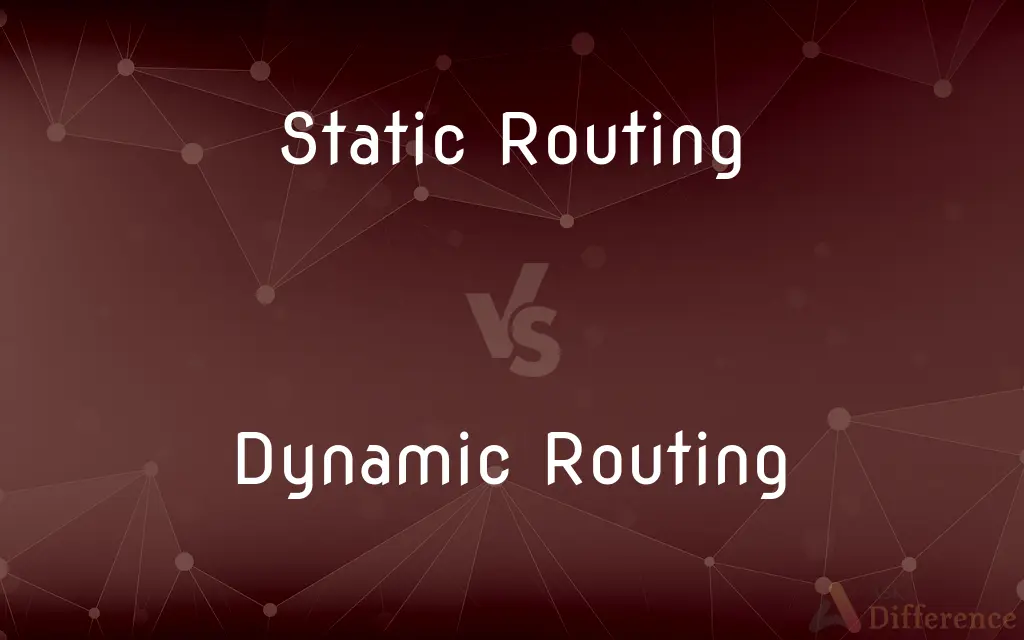Static Routing vs. Dynamic Routing — What's the Difference?
By Tayyaba Rehman & Fiza Rafique — Published on February 6, 2024
Static routing involves manually setting fixed paths for data packets, while dynamic routing automatically adjusts routes based on network changes.

Difference Between Static Routing and Dynamic Routing
Table of Contents
ADVERTISEMENT
Key Differences
Static Routing is a method where the routes are manually configured and added to the routing table. These routes remain constant unless manually changed. Dynamic Routing, in contrast, uses algorithms and protocols to automatically adjust routes in the routing table based on the current network conditions.
Static Routing is simple and provides a stable routing environment but lacks flexibility. It is ideal for smaller networks where routes don't change frequently. Dynamic Routing, on the other hand, can adapt to network changes, making it suitable for large, complex networks.
In Static Routing, the network administrator has full control over the routing decisions, which can enhance security. However, this can be time-consuming in large networks. Dynamic Routing, through its protocols, can quickly respond to network outages or changes, reducing downtime.
Static Routing is resource-efficient as it does not require additional processing to determine the best path. However, it can lead to inefficient routing if network conditions change. Dynamic Routing continually assesses the network, ensuring efficient use of available paths but at the cost of additional processing.
While Static Routing is easier to understand and implement, it can become cumbersome in large networks with frequent changes. Dynamic Routing requires a deeper understanding of routing protocols but offers greater scalability and flexibility in dynamic network environments.
ADVERTISEMENT
Comparison Chart
Configuration
Manually set by network administrators
Automatically adjusts using algorithms
Adaptability
Fixed, does not adapt to changes
Adapts to network changes dynamically
Suitability
Ideal for small or stable networks
Better for large or complex networks
Resource Usage
Less resource-intensive
Requires more processing power
Complexity and Management
Simpler to manage, less complex
More complex, requires understanding of protocols
Compare with Definitions
Static Routing
Static routing refers to manually configured network routes.
The network engineer used static routing to maintain a consistent path for data.
Dynamic Routing
Dynamic routing automatically adjusts routes based on network conditions.
Dynamic routing enabled the network to adapt quickly to the failed link.
Static Routing
Static routing involves predefined pathways for data packets.
In static routing, changes in network topology require manual route updates.
Dynamic Routing
Dynamic routing uses protocols like OSPF and BGP.
They implemented dynamic routing with BGP to ensure robust and efficient data transfer across the internet.
Static Routing
Static routing relies on manually set routing tables.
Static routing was implemented to control the exact routing paths in the secure network.
Dynamic Routing
Dynamic routing uses algorithms to find optimal paths.
The router's dynamic routing protocol efficiently managed the fluctuating network traffic.
Static Routing
Static routing is a fixed routing method without automatic adjustments.
Static routing was chosen for its simplicity and stability in the small office network.
Dynamic Routing
Dynamic routing is adaptable to changes in the network topology.
With dynamic routing, the network automatically rerouted traffic during the maintenance period.
Static Routing
Static routing is a non-adaptive routing strategy.
They used static routing to ensure data always followed the same network path.
Dynamic Routing
Dynamic routing involves real-time route determination.
Dynamic routing was essential for managing the complex, ever-changing enterprise network.
Common Curiosities
Is static routing complex?
Static routing is simpler and less complex, ideal for smaller networks or scenarios with limited bandwidth.
What is dynamic routing?
Dynamic routing is an adaptive routing method where routes are automatically adjusted based on current network conditions.
Can static routing adapt to network failures?
No, static routing cannot automatically adapt to network failures; it requires manual intervention.
Which routing is more secure, static or dynamic?
Static routing is generally considered more secure as it does not broadcast routing information.
When is static routing preferred?
Static routing is preferred in smaller or more stable networks where route changes are infrequent.
What are the advantages of dynamic routing?
Dynamic routing adapts to network changes, can handle complex networks, and reduces downtime due to automatic rerouting.
What is static routing?
Static routing is a network routing method where routes are manually set and do not change unless manually modified.
How does dynamic routing impact network resources?
Dynamic routing requires more processing power and memory due to its adaptive nature and continuous monitoring of the network.
How does dynamic routing choose the best route?
Dynamic routing uses algorithms and protocols to determine the most efficient path based on current network conditions.
Are there different types of dynamic routing protocols?
Yes, there are several types, including distance-vector, link-state, and path-vector protocols.
Is static routing suitable for large networks?
Static routing is less suitable for large networks due to its lack of adaptability and the need for manual configuration.
How does network size affect routing choice?
Larger, more complex networks typically benefit from dynamic routing, while smaller networks can efficiently use static routing.
Can static and dynamic routing be used together?
Yes, in some networks, a combination of static and dynamic routing is used to optimize performance and control.
Do dynamic routing protocols require frequent updates?
Dynamic routing protocols automatically update their routing tables, but the frequency depends on network changes and protocol specifics.
Can static routing lead to routing loops?
Yes, if not properly configured, static routing can lead to routing loops.
Share Your Discovery

Previous Comparison
Windows 7 Home Basic vs. Windows 7 UltimateAuthor Spotlight
Written by
Tayyaba RehmanTayyaba Rehman is a distinguished writer, currently serving as a primary contributor to askdifference.com. As a researcher in semantics and etymology, Tayyaba's passion for the complexity of languages and their distinctions has found a perfect home on the platform. Tayyaba delves into the intricacies of language, distinguishing between commonly confused words and phrases, thereby providing clarity for readers worldwide.
Co-written by
Fiza RafiqueFiza Rafique is a skilled content writer at AskDifference.com, where she meticulously refines and enhances written pieces. Drawing from her vast editorial expertise, Fiza ensures clarity, accuracy, and precision in every article. Passionate about language, she continually seeks to elevate the quality of content for readers worldwide.

















































